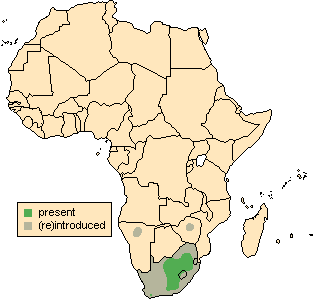![]() Return
to Artiodactyla
Return
to Artiodactyla
Classification
|
 Damaliscus
pygargus
Damaliscus
pygargus
Bontebok, Blesbok
![]()
Taxonomy
 |
 |
 |
Click on the pictures above for a larger view of the
photographs
|
||
General Characteristics
Body Length: 140-160 cm / 4.6-5.3 ft.
Shoulder Height: 85-100 cm / 2.8-3.3 ft.
Tail Length: 30-45 cm / 12-18 in.
Weight: 55-80 kg / 121-176 lb.The short, glossy coat is a purplish or reddish brown shade, becoming lighter on the back. The underparts and insides of the legs are white, with the outsides being the same colour as the body. While the rump of the blesbok (D. p. phillipsi) is the same color as the back, there is a white patch on the rump surrounding the tail of the bontebok (D. p. dorcas), whose lower legs are also white. There is a white blaze on the face, consisting of a slender patch on the forehead, and a wider, longer stripe down the nose. These two patches are continous in the bontebok, but are usually interrupted by a tiny dark band in the blesbok. Calves are born a light yellowish brown with dark faces, and have none of the markings of adults. Both sexes carry the strongly ridged, lyre-shaped horns, which grow 35-50 cm / 14-20 inches long.
Ontogeny and Reproduction
Gestation Period: 7.5-8.5 months.
Young per Birth: 1
Weaning: After about 4 months.
Sexual Maturity: 2.5 years.
Life span: Up to 17 years.The rut of the bontebok occurs during February, while blesbok typically breed between April and June. The female does not leave the herd to give birth, and calves have a strong instinct to follow their mothers.
Ecology and Behavior
This species is primarily diurnal, although there is a lull in activity during the hottest part of the day, spent resting in sheltered areas. Unlike many antelope, this species is not a good jumper, with a 135 cm / 4.5 foot high fence being tall enough to enclose a herd. However, they are adept at crawling under objects. When water is available, they drink at least once a day, although they can survive without water for several days. In the past, herds would migrate between seasonal pastures, congregating in large numbers during the fall and winter. As males approach maturity, bontebok form territories about 25-100 acres / 10-40 hectares in size, while the territories of blesbok are significantly smaller, only 2.5-6.3 acres. Old bulls are territorial, and mark their ranges prominently with dung heaps, on which they often rest. Other terriotorial marking include scrapes in the ground as well as secretions from the preorbital glands. A male generally remains on his territory year-round. Conflicts between neighbouring males over territorial boundaries are rare, consisting primarily of ritualized parallel displays. Small herds of females and their young circulate through several individual territories during the breeding season. Marking of plant stalks with preorbital gland secretions is seen in both sexes.Family group: Male, female, and mixed herds are found, rarely exceeding 40 (bontebok) or 70 (blesbok) animals in number.
Diet: Short grasses.
Main Predators: Lion, leopard, cheetah, hyena, Cape hunting dog.
Distribution
Grasslands of highveld and coastal plains in southwestern South Africa (bontebok), and eastern and central South Africa (blesbok).

Range Map (Redrawn from IEA, 1998)
Conservation Status
The bontebok is classified as vulnerable by the IUCN (1996).
Remarks
The bontebok (D. p. dorcas) and blesbok (D. p. phillipsi) are part of a confusing taxonomic muddle. Formerly both classified as subspecies of Damaliscus dorcas, the Smithsonian Institution has changed the classification of both to Damaliscus pygargus. However, this name has not completely infiltrated into current usage, with both 'species' still being placed under D. dorcas by certain taxonomists. The problem arises from their extreme genetic closeness - they look almost identical and could be (and have been) thought of as races. As with many South African species, the bontebok was once hunted to the brink of extinction by white settlers who viewed them as pests. Once reduced to just 17 wild individuals, the bontebok population has since grown, and over a thousand animals now live on preserves and game farms in their home land. The blesbok is now extinct in its native habitat, only surviving on game farms and in wildlife refuges. The population has increased to the point where they are commercially ranched for meat. The name bontebok comes from bont (Dutch) particolored and bok (Dutch) a buck. Bles (Dutch) a mark or blaze; bok (Dutch) a buck: alluding to the white blaze on the nose.
Damalis (Greek) a young cow, a heifer; -iscus (Latin) diminutive suffix. Puge (Greek) the rump; argos (Greek) shining, bright: hence pugargos (Greek) white-rump.
Literature Cited
Alden, P. C., R. D. Estes, D. Schlitter, and B. McBride. 1995. National Audubon Society Field Guide to African Wildlife. New York: Chanticleer Press.IEA (Institute of Applied Ecology). 1998. Damaliscus pygargus. In African Mammals Databank - A Databank for the Conservation and Management of the African Mammals Vol 1 and 2. Bruxelles: European Commission Directorate. Available online at http://gorilla.bio.uniroma1.it/amd/amd160b.html
Kingdon, J. 1997. The Kingdon Field Guide to African Mammals. Academic Press, London and New York: NaturalWorld.
Walther, F. R. 1990. Hartebeests. In Grzimek's Encyclopedia of Mammals. Edited by S. P. Parker. New York: McGraw-Hill. Volume 5, pp. 418-436.
Wilson, D. E., and D. M. Reeder [editors]. 1993. Mammal Species of the World (Second Edition). Washington: Smithsonian Institution Press. Available online at http://nmnhwww.si.edu/msw/
Return to Artiodactyla

![]()
© Brent Huffman, www.ultimateungulate.com |
|
|